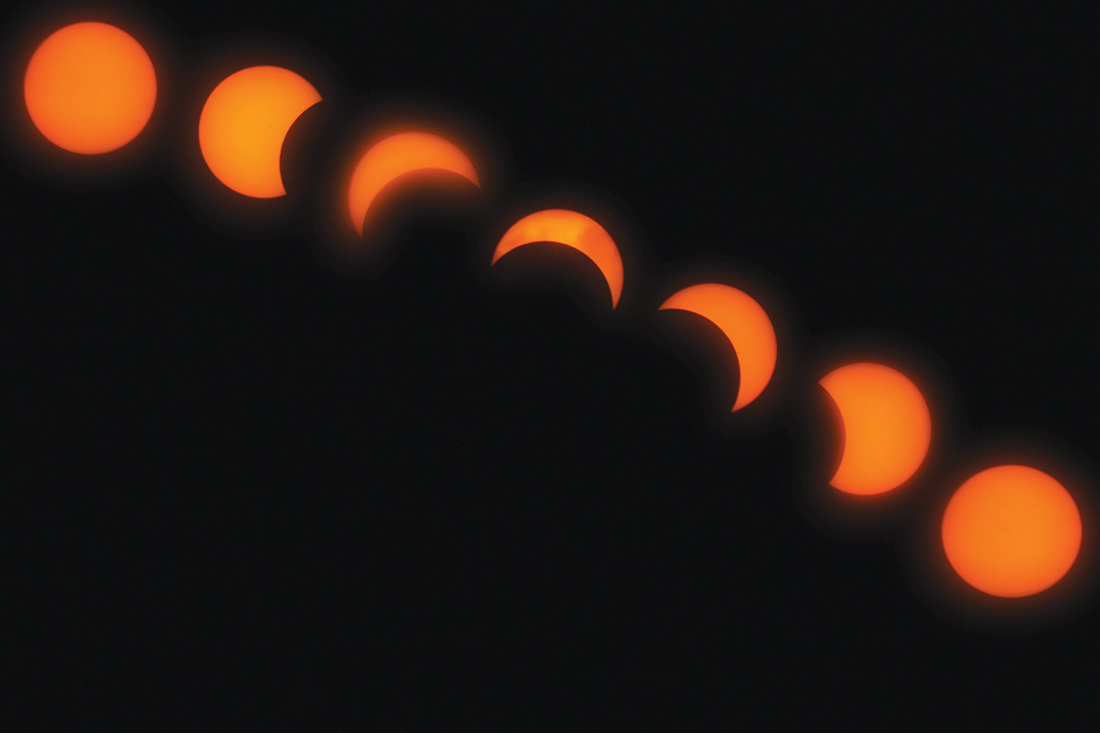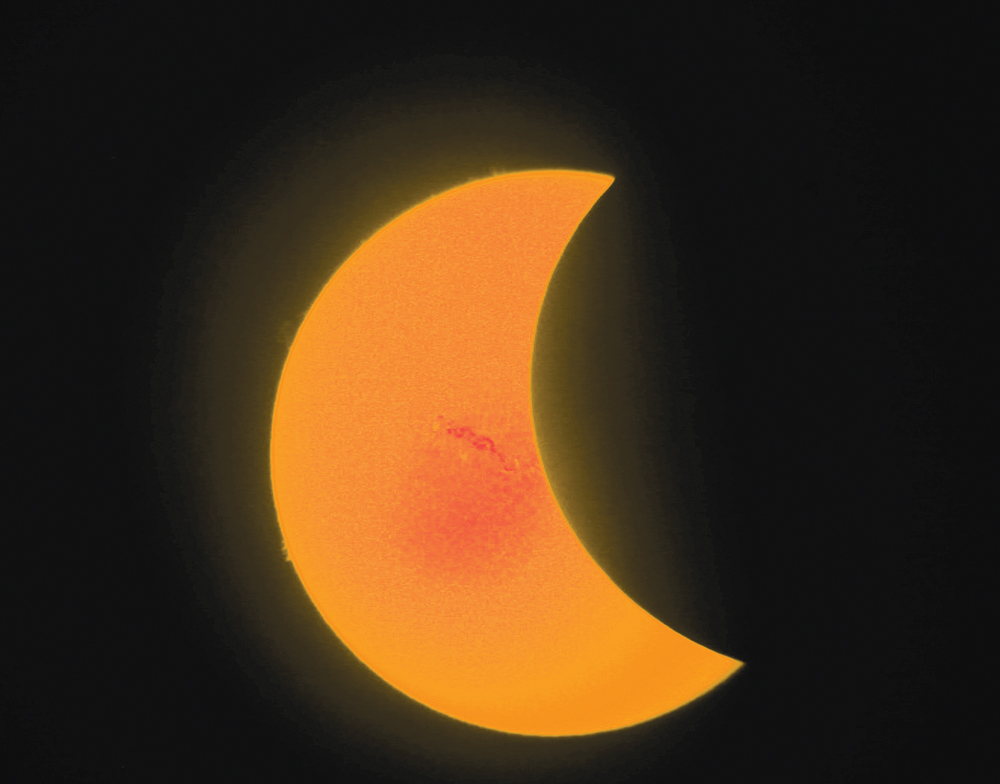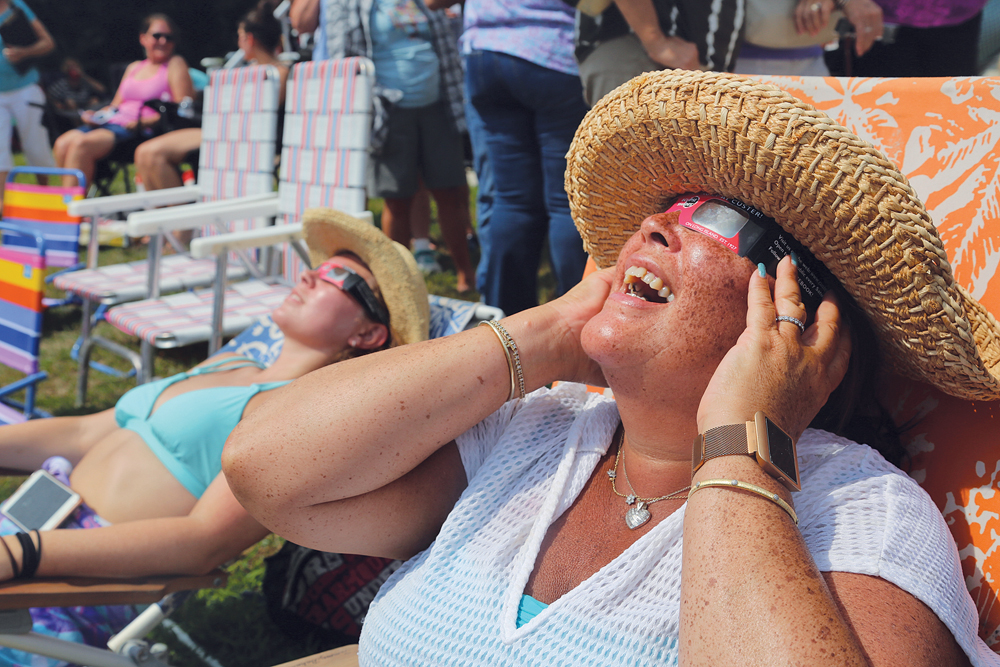Column: Enjoying the Great American Eclipse

Standing amid a crowd of hundreds Monday afternoon, Fred Sandusky held a yellow Cheerios box with a tiny pinhole up toward the sun.
Safely viewing the rare solar eclipse that swept across the nation required some ingenuity. Makeshift camera obscuras made from cereal boxes could be spotted throughout the crowd at the Custer Institute & Observatory in Southold — the North Fork’s premier gathering spot to view the eclipse. Mr. Sandusky had pieced his box together on the way to the observatory.
I was one of the lucky ones.
A few weeks earlier, as eclipse-mania began, I spent $15 on Amazon to purchase a 10-pack of specially designed glasses. As the eclipse grew nearer, the glasses became harder and harder to find as people snatched up remaining inventory in stores and online prices spiked. Nancy Loeffler of Cutchogue carried a bag of crackers after seeing on TV that the holes could form a pinhole view.
As I walked through the crowd Monday, I lent my glasses to some people who weren’t equipped with their own. I’ve never seen people so grateful.
I’ve never considered myself a science or astronomy buff, but when I heard about the unique opportunity to see the moon block out — in the North Fork’s case — about 70 percent of the sun, I couldn’t help but get swept up in the hype.
My glasses were decorated with stars and American flags — it was called the Great American Eclipse after all.
“Oh, wow!” said Margaret Luckey of Mastic Beach as she looked upward to see the show, wearing the glasses I handed her. She excitedly passed the pair to her family.
I quickly found there’s nothing like watching people’s reactions to seeing a solar eclipse, even a partial one. (Totality, the point at which the moon completely blocks the sun, was visible in an arc across the country from Oregon down to South Carolina.)
The eclipse began at 1:26 p.m. Soon enough, there were “oohs” and “aahs,” drawn-out “wows” and other expressions not suitable for print. Seeing so many people’s jaws drop and grins emerge at sight of it all became the highlight of the eclipse experience for this reporter.
It also became my mission for the afternoon.
Staff members from the Custer Institute — where a view of the eclipse through telescopes outfitted to view the sun was available — wandered the grounds with a few pairs of glasses visitors could use.

Zachary Vavaz of Brooklyn, 6, sat on a beach chair next to his grandmother and offered his astute description of his view at 1:53 p.m. as the moon covered a bit more of the sun.
“It looks like a form of the moon,” he said.
Later, Anya Braven of New York City, 5, called it an “orange moon” as she looked through the filtered spectacles.
Terri and Bob Czensazk of Mattituck stood on line to check out the telescopes. I handed over the disposable glasses.
“It’s like a bite out of a cracker,” Ms. Czensazk said, which I agreed was an accurate account.
Mr. Czensazk found me later and sent me a great photo he took through a telescope with his iPhone.
It was a little after 2 p.m. when I saw Steve Etimos of East Islip holding up two pieces of cardboard, trying to line up a pinhole to the sun. It wasn’t working well, he admitted. He was there with his wife, Debbie, and friends Linda and Russ Colombo of East Marion.
I passed the glasses to the group and watched as each stepped out from under a tent to take it all in. Ms. Colombo was first.
“You’ve got to see this,” she said, handing the viewers over to her friends. They smiled, laughed, looked up in awe and thanked me for sharing.
Vito Piché of Aquebogue found me a couple of times to see the various stages of the eclipse, which I happily allowed in exchange for a quick photo.
Matt Campbell of the Custer Institute said the eclipse was opportunity to educate people. People have been curious about eclipses, asking why they don’t occur more often, he said, though the most popular question he’s heard in the last three weeks is, “Can I get some glasses?”

He estimated that about 500 people showed up at the Custer Institute Monday.
“It’s like beyond astronomy now,” he said of the crowd. “Like, ‘Hey, let’s all have some fun out here.’ ”
Visitors brought beach chairs and blankets, some tanned or picknicked as they waited and watched.
“It really is a rare event,” Mr. Campbell said. “To see the sun getting blocked out by the moon, even though we’re not totality here.”
The next solar eclipse viewable in New York will occur April 8, 2024, and will feature totality across portions of upstate.
Be sure to grab your glasses by then.
Top photo caption: Ruthanne McCormack of Cutchogue takes in the solar eclipse through protective eyewear at the Custer Institute & Observatory in Southold. (Credit: Kelly Zegers)
 The author is a staff writer for The Suffolk Times and Riverhead News-Review. She can be reached at 631-354-8026 or [email protected].
The author is a staff writer for The Suffolk Times and Riverhead News-Review. She can be reached at 631-354-8026 or [email protected].










